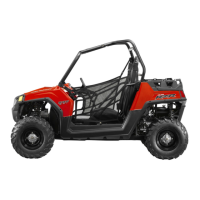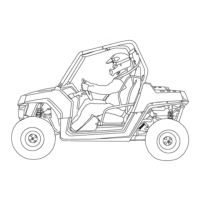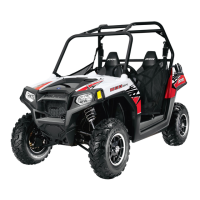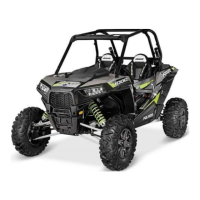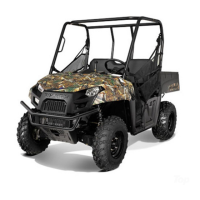6.8
CLUTCHING
Belt Inspection
1. Measure belt width and replace if worn severely.
• The top edges have been trimmed on some drive belts.
It will be necessary to project the side profiles and
measure from corner to corner.
• Place a straight edge on each side of the drive belt.
• Place another straight edge on top of belt.
• Measure the distance where the side straight edges
intersect the top.
2. Inspect belt for loose cords, missing cogs, cracks,
abrasions, thin spots, or excessive wear. Replace if
necessary.
3. Inspect belt for hour glassing (extreme circular wear in at
least one spot and on both sides of the belt). Hour glassing
occurs when the drive train does not move and the drive
clutch engages the belt.
4. Measure belt length with a tape measure around the outer
circumference of the belt.
5. Replace belt if worn past the wear limit. Belts with thin
spots, burn marks, etc., should be replaced to eliminate
noise, vibration, or erratic PVT operation. See the
Troubleshooting Chart at the end of this chapter for
possible causes.
Belt Installation
NOTE: Be sure to position belt in the same position
as when removed or so part number is easily read.
1. Loop belt over the drive clutch and over top of the driven
sheave.
2. While pushing down on top of belt, turn the back, or
moveable driven sheave, clockwise.
3. The belt then should be able to be pushed down into and
between the sheaves.
PVT Break-In (Drive Belt / Clutches)
A proper break-in of the clutches and drive belt will ensure a
longer life and better performance. Break in the clutches and
drive belt by operating at slower speeds during the 10 hour
break-in period as recommended (see Chapter 3 “Engine
Break-In Period” for break-in example). Pull only light loads.
Avoid aggressive acceleration and high speed operation during
the break-in period.
Belt Width
New: 1.188” (3.02 cm)
Wear Limit: 1.157 (2.94 cm)
Belt Outer Circumference
New: 40.89” (103.85 cm)
Wear Limit: 41.08” (104.34 cm)
Projected Belt Width

